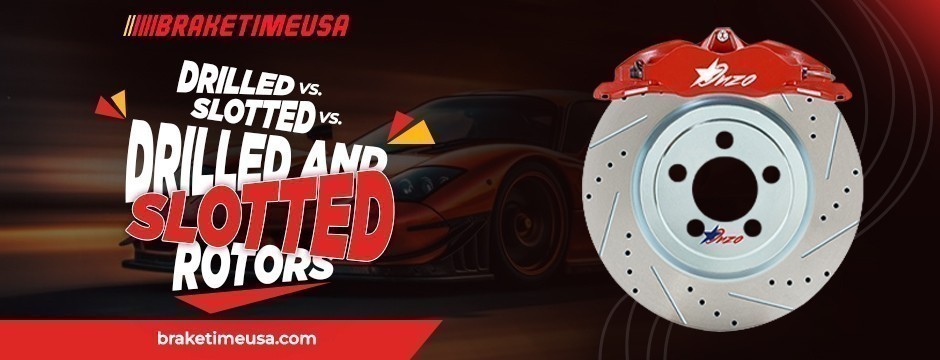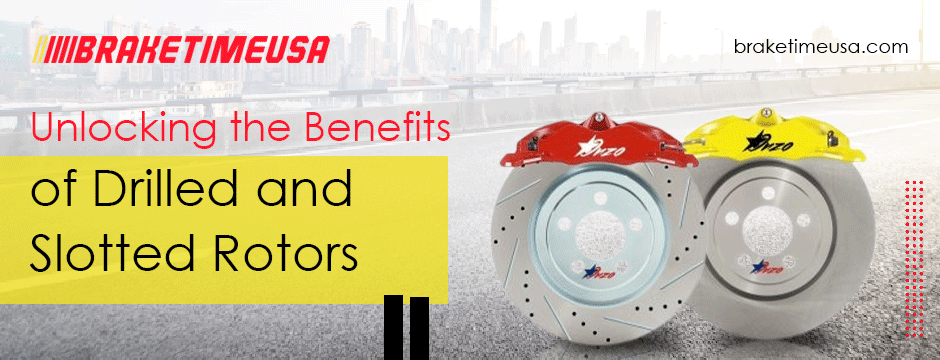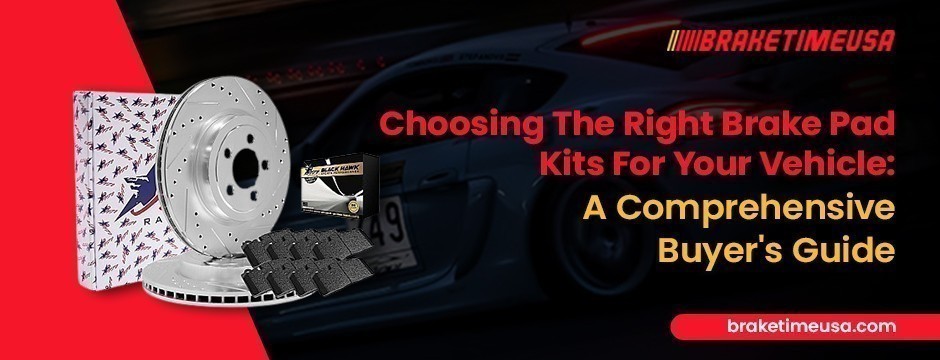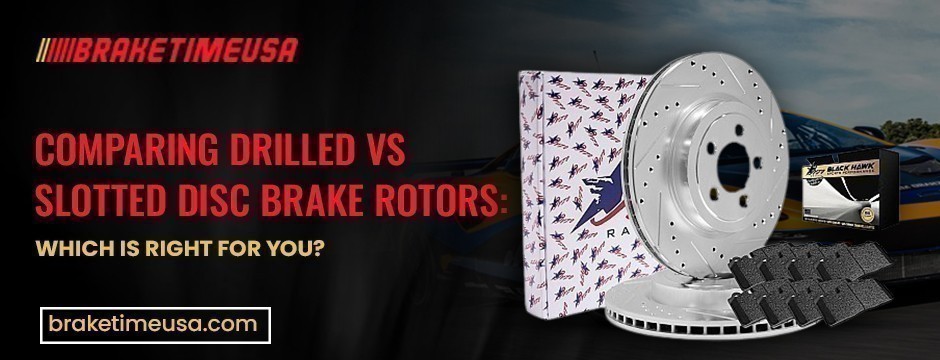Your cart is empty
Subtotal:$0.00
When it comes to enhancing your vehicle's braking performance, upgrading your brake rotors is a common consideration. Among the various options available, drilled and slotted rotors have gained popularity for their potential to improve braking efficiency. But the question remains: are drilled and slotted rotors better for your brake system? In this comprehensive guide, we'll delve into the differences, benefits, and considerations of both types, helping you make an informed decision to enhance your vehicle's stopping power. Understanding Brake Rotors
Understanding Brake Rotors
Before we jump into the drilled vs. slotted rotors debate, let's establish a fundamental understanding of what brake rotors are and how they function in your vehicle's braking system.
Heat Dissipation: Drilled rotors feature holes or perforations drilled into the rotor's surface. These holes aid in dissipating heat generated during braking. By reducing heat buildup, drilled rotors are less prone to brake fade, which can occur when brakes overheat and become less effective.
Improved Wet Braking: The holes in drilled rotors also assist in dispersing water and moisture from the braking surface. This feature can enhance wet weather braking performance by maintaining consistent contact between the brake pads and rotor.
Aesthetics: Drilled rotors often appeal to car enthusiasts due to their sporty and aggressive appearance. If you value the aesthetics of your vehicle's braking components, drilled rotors may be an attractive choice.
Structural Integrity: The process of drilling holes into rotors may compromise their structural integrity. Over time, the stress and heat cycles of braking can lead to cracks around the drilled holes, potentially reducing rotor lifespan.
Noise and Vibration: Some drivers have reported increased noise and vibration when using drilled rotors. This noise is typically a result of the holes in the rotor's surface interacting with the brake pads.
Consistent Braking: Slotted rotors feature shallow channels or slots machined into the rotor's surface. These slots help maintain consistent contact between the brake pads and rotor, reducing the risk of brake fade and improving overall braking performance.
Improved Bite: The slots in slotted rotors can enhance the initial "bite" of the brakes. This means that when you apply the brakes, you'll experience more immediate and responsive stopping power.
Durability: Slotted rotors tend to be more durable than drilled rotors. The absence of drilled holes means there are no weak points susceptible to cracking, making slotted rotors a robust choice.
Heat Dissipation: While slotted rotors still provide effective heat dissipation, they may not perform as well in this regard as drilled rotors. If you frequently engage in high-performance driving or towing heavy loads, drilled rotors might offer better heat management.
Aesthetics: Slotted rotors may not have the same visual appeal as drilled rotors for those who value the sporty look. However, aesthetics are subjective, and some drivers may prefer the clean and purposeful appearance of slotted rotors.
1. Improved Heat Dissipation: Drilled and slotted rotors excel in dissipating heat generated during braking. The drilled holes and slotted channels provide additional pathways for heat to escape, preventing brake fade and maintaining consistent performance during intense use.
2. Enhanced Wet Weather Performance: The slots in drilled and slotted rotors help disperse water and debris, offering improved braking performance in wet conditions. This design minimizes the risk of hydroplaning and enhances overall safety during adverse weather.
3. Reduced Brake Glazing: The combination of drilled holes and slotted channels prevents brake glazing—a condition where a smooth and shiny film develops on the surface of the brake pads. This ensures a clean and effective contact surface, optimizing braking performance.
4. Aesthetic Appeal: Drilled and slotted rotors often add a stylish and sporty appearance to the vehicle. The visual appeal can be a significant factor for car enthusiasts seeking not only improved performance but also an enhanced aesthetic.
5. Versatility for Various Driving Conditions: Drilled and slotted rotors offer a balanced solution suitable for a variety of driving conditions. Whether you're a sports performance enthusiast, engage in truck towing, or use your vehicle for daily commuting, these rotors cater to diverse driving needs.
Pros of Drilled and Slotted Rotors:
1. Cost: One of the notable drawbacks of drilled and slotted rotors is the cost. Compared to traditional solid rotors, the drilled and slotted variety tends to be more expensive. However, many enthusiasts argue that the performance benefits justify the higher price tag.
2. Noise: Drilled and slotted rotors can be noisier than their solid counterparts. The slots and holes can produce a distinct sound during braking, which some drivers may find bothersome. However, the noise level can vary depending on the specific rotor design and driving conditions.
3. Potential for Cracking: There is a theoretical risk of drilled rotors developing cracks, especially under extreme stress conditions. However, it's essential to note that modern manufacturing techniques and high-quality materials have significantly mitigated this risk. Regular inspection and proper maintenance can help address this concern.
4. Not Ideal for Track Racing: While drilled and slotted rotors are well-suited for various driving conditions, they may not be the optimal choice for track racing. In high-performance racing scenarios, specialized rotors with different designs may be preferred.
Now that we've explored the pros and cons of each rotor type, let's delve deeper into the key differences between drilled and slotted rotors:
Drilled Rotors: Drilled rotors are recognizable by the evenly spaced holes or perforations that are drilled through their surface. These holes extend radially from the center of the rotor, creating a distinctive appearance.
Slotted Rotors: In contrast, slotted rotors feature shallow channels or slots machined into their surface. These slots are typically parallel to one another and run circumferentially around the rotor. The design of slotted rotors imparts a clean and purposeful look.
Drilled Rotors: Drilled rotors are renowned for their exceptional heat dissipation capabilities. The numerous holes on their surface facilitate the rapid dispersion of heat generated during braking. This feature is particularly advantageous in high-performance driving scenarios where brakes can heat up significantly.
Slotted Rotors: While slotted rotors also effectively dissipate heat, they may not perform as well as drilled rotors in extreme heat conditions. However, for most everyday driving situations, slotted rotors provide sufficient heat management.
Drilled Rotors: Drilled rotors may exhibit a slightly less sharp initial bite compared to slotted rotors. The presence of holes can alter the initial responsiveness of the brakes. However, this difference is often subtle and may not be noticeable in normal driving conditions.
Slotted Rotors: Slotted rotors excel in providing an excellent initial bite. This means that when you apply the brakes, you experience immediate and responsive stopping power. Slotted rotors are particularly favored by drivers who prioritize quick and assertive braking.
Drilled Rotors: Some drivers have reported noise and vibration when using drilled rotors. This noise is primarily attributed to the interaction between the holes on the rotor's surface and the brake pads. The noise level can vary based on driving conditions and the specific brake pad material.
Slotted Rotors: Slotted rotors tend to produce less noise and vibration compared to drilled rotors. The design of the slots allows for smoother contact with the brake pads, resulting in a quieter and more refined braking experience.
Drilled Rotors: Drilled rotors are often favored for their sporty and aggressive appearance. The presence of holes adds a unique visual element to the braking components, making them appealing to car enthusiasts who value aesthetics and want to showcase their high-performance brakes.
Slotted Rotors: Slotted rotors offer a cleaner and purposeful appearance. They have a timeless design that suits various vehicle styles. If you prefer a more understated look for your vehicle's braking components, slotted rotors may be the better choice.
The decision between drilled and slotted rotors should align with your specific needs, driving habits, and vehicle type:
High-Performance Driving: If you frequently engage in high-performance driving activities, such as track days or spirited drives on challenging roads, drilled rotors may be your preferred choice. Their superior heat dissipation capabilities can help maintain consistent braking performance under demanding conditions.
Everyday Driving: For daily commuting and typical road conditions, slotted rotors provide excellent braking performance and durability. They are well-suited for regular driving situations.
Performance Vehicles: Performance-oriented vehicles with powerful engines and aggressive braking requirements may benefit from the heat management advantages of drilled rotors.
Sedans and SUVs: Sedans, SUVs, and daily drivers can benefit from the improved initial bite and durability offered by slotted rotors. These rotors provide reliable braking performance for everyday use.
Wet Climates: If you reside in an area with frequent rain or wet road conditions, slotted rotors can help maintain consistent braking performance due to their enhanced initial bite and water-dispelling design.
Dry Climates: In dry climates with high temperatures, drilled rotors may be more effective at managing heat buildup during prolonged braking situations.
Noise Tolerance: Consider your sensitivity to noise and vibration. If you prefer a quieter and smoother braking experience, especially during everyday driving, slotted rotors are a suitable choice.
Visual Preference: Reflect on your visual preferences and how the rotor design complements your vehicle's overall appearance. Drilled rotors offer a sporty and eye-catching look, while slotted rotors provide a cleaner and more refined appearance.
NASCAR, a pinnacle of high-speed racing, employs a unique rotor design—smaller slots surrounding the rotor, coupled with drilled holes. This combination is specifically tailored to the extreme demands of racing. However, it's important to note that Nascar's rotor configuration is specialized for racing conditions and may not be ideal for everyday use.
When deciding between Drilled, Slotted, and Drilled and Slotted rotors, it ultimately comes down to the driving type and performance requirements. Drilled and Slotted rotors offer a balanced solution that caters to various driving styles. Sports performance enthusiasts, truck/tow applications, and daily drivers can all benefit from the aesthetic appeal and enhanced performance of the Drilled and Slotted combination.
The debate over Drilled Vs. Slotted Vs. Drilled and Slotted has a clear winner for those seeking a versatile and high-performance solution. The Drilled and Slotted hybrid not only looks the part but also delivers the best of both worlds—efficient heat dissipation, debris clearance, and consistent pad contact. For enthusiasts who demand optimal braking performance across different driving scenarios, Drilled and Slotted rotors emerge as the top choice, ensuring a safe and stylish ride on the road.
To find out more, visit us at ! Mar 27, 2024Unlocking the Benefits of Drilled and Slotted Rotors
Mar 27, 2024Unlocking the Benefits of Drilled and Slotted Rotors Mar 22, 2024Choosing The Right Brake Pad Kits For Your Vehicle: A Comprehensive Buyer's Guide
Mar 22, 2024Choosing The Right Brake Pad Kits For Your Vehicle: A Comprehensive Buyer's Guide Mar 18, 2024Exploring Different Types of Rear Brake Rotors
Mar 18, 2024Exploring Different Types of Rear Brake Rotors Mar 6, 2024Comparing Drilled vs. Slotted Disc Brake Rotors: Which Is Right for You?
Mar 6, 2024Comparing Drilled vs. Slotted Disc Brake Rotors: Which Is Right for You?
 Feb 5, 2024Comprehensive Guide on How To Check Brake Pads and Rotors for Optimal Maintenance
Feb 5, 2024Comprehensive Guide on How To Check Brake Pads and Rotors for Optimal Maintenance© 2023 - 2024 Braketimeusa. All rights reserved.
